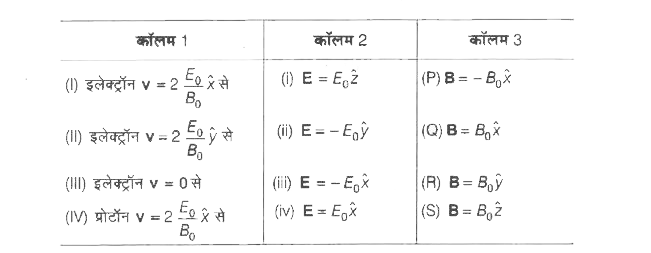In which case would the particle move in a straight line along the negative direction of y-axis i.e. move along - ˆy ?By appropriately matching the information given in the three columns of the following table.A charged particle electron or proton is introduced at the origin x = 0 y = 0 z = 0 with a given initial velocity vector v. A uniform electric field vector E and a uniform magnetic field vector B exist everywhere. The velocity vector v electric field vector E and magnetic field vector B are given in columns 1 2 and 3 respectively. The quantities E0 B0 are positive in magnitude.A II iii Q B III ii R C IV ii S D III ii P
The correct answer is:
Related Solutions
A positively charged particle moving along x-axis with a certain velocity enters a uniform electric field directed along positive y-axis. Its
View SolutionA positively charged particle moving along x - axis with a certain velocity enters a uniform electric field directed along positive y-axis. Its
View SolutionA positively charge particle moving along x -axis with a certain velocity enters a uniform electric field directed along positively y-axis. Its
View SolutionA positively charged particle moving along x-axis with a certain velocity enters a uniform electric field directed along positive y-axis. Its
View Solutionकिसी स्थिति में कण सीधी रेखा में ऋणात्मक y-अक्ष (negative y-axis) की दिशा में चलेगा?
 View Solution
View SolutionA particle of charge and of mass is projected along the -axis at from origin with a velocity . If a uniform electric field also exist along the -axis, then the time at which debroglie wavelength of the particle becomes half of the initial value is:
View SolutionA particle of charge q_(0) and of mass m_(0) is projected along the y -axis at t=0 from origin with a velocity V_(0) . If a uniform electric field E_(0) also exist along the x -axis, then the time at which debroglie wavelength of the particle becomes half of the initial value is:
View SolutionAn electron moving with a constant velocity v along X-axis enters a uniform electric field applied along Y-axis. Then, the electron moves
View SolutionA proton is moving along the negative direction of X-axis in a magnetic field directed along the positive direction of Y-axis. The proton will be deflected along the negative direction of
View SolutionA proton is moving along the negative direction of X-axis in a magnetic field directed along the positive direction of Y-axis. The proton will be deflected along the negative direction of
View SolutionA particle of charge moving with velocity along the X-axis enters a region of magnetic field of induction B along V-axis and an electric field of strength along negative Z-axis. If the charged particle continues to move along the X-axis, the magnitude of B is
View SolutionA charged particle (electron or proton) is introduced at the origin ) with a given initial velocity . A uniform electric field and a uniform magnetic field exist everywhere. The velocity , electric field and magnetic field are given in columns 1,2 and 3 respectively. The quantities are positive in magnitude.
In which case would the particle move in a straight line along the negative direction of y-axis (i.e., move alongView SolutionTwo particles A and B move along the straight lines x+2y+3=0 and 2x+y-3=0 respectively. Their positive vector, at the time of meeting will be
View SolutionTwo particles A and B move along the straight lines x+2y+3=0 and 2x+y-3=0 respectively. Their positive vector, at the time of meeting will be
View SolutionTwo particles A and B move along the straight lines x+2y+3=0 and 2x+y-3=0 respectively. Their positive vector, at the time of meeting will be
View SolutionUniform electric field E and magnetic field B, respectively, are along y-axis as shown in the figure. A particle with specific charge q/m leaves the origin O in the direction of x-axis with an initial non-relativistic speed .

The angle between the particle’s velocity vector and y-axis at that moment is:View SolutionFor which of the following graphs the average velocity of a particle moving along a straight line for time interval must be negative
View SolutionFor which of the following graphs the average velocity of a particl moving along a straight line for time interval (0,t) must be negative -
View SolutionFor which of the following graphs the average velocity of a particl moving along a straight line for time interval (0,t) must be negative -
View SolutionIf the magnetic field is parallel to the positive y axis and the charged particle is moving along the positive x axis, then what would be the direction of Lorentz force be for:- a proton.
View Solution
